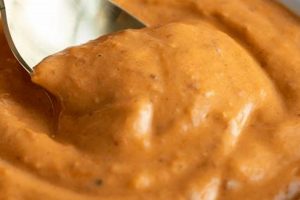A plant-based substitute for a fermented condiment traditionally made with anchovies, offers a flavor profile that mimics the umami-rich, tangy, and slightly sweet taste of the original. Common ingredients in these substitutes include soy sauce, balsamic vinegar, tamarind paste, molasses, and spices. These components combine to replicate the complex savory characteristics that the original sauce imparts to dishes.
The increased demand stems from dietary restrictions and ethical considerations. Individuals adhering to vegan lifestyles or those with fish allergies seek alternatives that provide a similar depth of flavor without compromising their principles or health. Historically, the need for substitutes has grown alongside the increasing awareness of food sensitivities and the rise in plant-based diets.
The subsequent sections will delve into specific ingredients used in creating these replacements, discuss methods for preparing homemade versions, analyze commercially available options, and explore the culinary applications of these flavor enhancers in various recipes.
Tips for Selecting a Plant-Based Worcestershire Sauce Substitute
This section provides guidance on choosing a suitable replacement for traditional Worcestershire sauce that aligns with a vegan lifestyle. Considerations are given to flavor profiles, ingredients, and culinary applications.
Tip 1: Examine the Ingredient List: Scrutinize the ingredients to ensure the absence of animal-derived products such as anchovies, bone broth, or other non-vegan additives. Look for ingredients like soy sauce, vinegar, molasses, and spices.
Tip 2: Evaluate Sodium Content: Many condiments, including Worcestershire sauce substitutes, can be high in sodium. Compare the sodium levels across different brands and opt for lower-sodium options, particularly for individuals managing their sodium intake.
Tip 3: Consider Flavor Profile: Taste descriptions can vary. Some alternatives emphasize the smoky notes, while others focus on sweetness or acidity. Consider the intended application and select a flavor profile that complements the dish.
Tip 4: Opt for Organic Options: Choosing organic plant-based Worcestershire sauce alternatives can minimize exposure to pesticides and herbicides, aligning with health-conscious preferences.
Tip 5: Explore Homemade Alternatives: Creating a substitute from scratch allows for complete control over ingredients and flavor customization. Recipes typically involve combining ingredients such as soy sauce, balsamic vinegar, tamarind paste, and spices.
Tip 6: Read Reviews and Ratings: Consult online reviews and ratings from other consumers to gauge the overall satisfaction and flavor accuracy of various brands.
Tip 7: Understand the Source of Umami: Plant-based substitutes typically derive their umami flavor from ingredients such as soy sauce, nutritional yeast, or mushroom extracts. Awareness of these sources can assist in understanding the flavor nuances.
By carefully considering the ingredient list, sodium content, flavor profile, and user reviews, an appropriate plant-based Worcestershire sauce substitute can be identified to meet dietary requirements and culinary needs.
The subsequent section will provide recipes that can make use of the vegan Worcestershire sauce alternative to enhance a meal.
1. Ingredient Substitution
The creation of a plant-based Worcestershire sauce hinges fundamentally on strategic ingredient substitution. Traditional Worcestershire sauce derives its characteristic umami flavor largely from anchovies, a component clearly incompatible with vegan dietary guidelines. Therefore, successful formulation of an acceptable alternative necessitates identifying plant-derived ingredients capable of replicating this savory depth and complexity. The omission of anchovies directly causes the absence of the core flavor component, demanding a resourceful approach to rebuilding the flavor profile. Without deliberate and effective ingredient substitution, a truly vegan substitute remains unattainable.
Examples of this substitution in practice abound. Soy sauce, known for its naturally high glutamate content, frequently serves as a base, contributing saltiness and a foundational umami note. Tamarind paste, derived from a fruit, adds a crucial sweet-sour tang, while molasses introduces both sweetness and color depth. Often, a blend of spices such as cloves, garlic, and chili powder are incorporated to further mimic the intricate flavor matrix of the original sauce. Mushroom extracts or powders can also be included for their potent umami characteristics. The practical significance of understanding ingredient substitution lies in the ability to critically evaluate commercially available products and, potentially, formulate personalized versions at home, tailored to individual palates.
In conclusion, ingredient substitution is not merely a component of formulating a vegan alternative to Worcestershire sauce; it represents the very essence of the endeavor. Overcoming the challenge of replacing anchovies with plant-based ingredients requires a deep understanding of flavor chemistry and the strategic deployment of specific elements to reconstruct the desired taste profile. Ultimately, the successful application of this substitution process determines the viability and authenticity of the resulting plant-based condiment. This focus is paramount for both consumers seeking suitable replacements and manufacturers aiming to cater to the growing market demand for vegan products.
2. Umami Replication
Umami replication forms a core challenge in crafting a credible plant-based substitute for Worcestershire sauce. The inherent savory depth of traditional Worcestershire stems, in part, from glutamates present in anchovies. Consequently, a successful vegan alternative necessitates the incorporation of plant-derived compounds capable of delivering a comparable umami sensation.
- The Role of Glutamates
Glutamates are amino acids responsible for triggering the umami taste receptor. In vegan Worcestershire substitutes, ingredients such as soy sauce, miso paste, and nutritional yeast serve as key glutamate sources. The concentration and type of glutamate-containing components significantly impact the overall flavor profile, determining the authenticity of the umami experience. For example, a product relying solely on hydrolyzed vegetable protein may present a less nuanced umami compared to one employing a combination of soy sauce and mushroom extract. This highlights that successful umami replication needs a balanced and diversified glutamate profile, rather than just a high level of glutamates.
- Fermentation Processes
Fermentation plays a crucial role in enhancing umami. Ingredients like soy sauce and miso undergo fermentation, which breaks down proteins into free amino acids, including glutamates. Vegan Worcestershire sauce alternatives that incorporate fermented ingredients often exhibit a richer, more complex umami flavor. Furthermore, fermentation introduces additional flavor compounds, contributing to the overall depth and complexity of the sauce. For example, using a naturally brewed soy sauce will contribute more complexity than a chemically produced one. The fermentation process must be well-controlled to maintain a desirable flavor and prevent the production of off-flavors.
- Mushroom-Derived Umami
Certain mushroom varieties, such as shiitake and porcini, possess naturally high levels of glutamates and other umami-enhancing compounds. Mushroom extracts and powders are frequently utilized in vegan Worcestershire sauce alternatives to bolster the umami flavor. These ingredients contribute an earthy, savory dimension that complements other flavor components. For example, shiitake mushroom powder can be added to a soy sauce-based Worcestershire alternative to add more layers of savory richness. The sourcing and processing of mushrooms impacts the final flavor, as different methods can yield distinct umami characteristics.
- Balancing Acidity and Sweetness
Umami perception is significantly influenced by the interplay of acidity and sweetness. In vegan Worcestershire alternatives, ingredients like vinegar, tamarind, and molasses are used to create a balance that enhances the savory notes. An appropriate level of acidity sharpens the umami, while a touch of sweetness rounds out the overall flavor profile. Too much acidity or sweetness can mask the umami, rendering the sauce unbalanced. For instance, the addition of balsamic vinegar can deepen savory notes. Proper balancing of these elements is essential for achieving a palatable and authentic flavor experience.
In summary, the successful umami replication in a vegan Worcestershire sauce alternative relies on a strategic combination of glutamate sources, often leveraging fermentation, mushroom-derived components, and a delicate balance of acidity and sweetness. The precise formulation dictates the authenticity and palatability of the final product, ultimately determining its viability as a substitute for the traditional, anchovy-based condiment.
3. Flavor Profile
The flavor profile represents a critical attribute of any successful plant-based substitute for Worcestershire sauce. Achieving a taste that approximates the complex, savory, and tangy characteristics of the original is paramount for consumer acceptance and culinary applicability. This section dissects key facets of the flavor profile in these alternatives.
- Umami Intensity and Source
A primary component of the flavor profile is the umami sensation. Plant-based substitutes commonly derive this savory depth from ingredients like soy sauce, nutritional yeast, or mushroom extracts. The source significantly influences the character of the umami. Soy sauce provides a salty, fermented umami, while nutritional yeast offers a cheesy, nutty variant. A successful substitute balances these sources to avoid a one-dimensional flavor. Commercial examples demonstrate varying intensities; some focus on subtle umami, while others strive for a more pronounced, assertive taste. Imbalances in umami intensity can lead to either a bland or overpowering final product.
- Acidity and Tanginess
Tanginess, contributed primarily by acidic components, is another defining characteristic. Vinegars, such as balsamic, apple cider, or white vinegar, are frequently employed to replicate this aspect. The type and concentration of vinegar significantly alter the overall flavor. Balsamic vinegar imparts sweetness and complexity, while white vinegar provides a sharper, more straightforward tang. The interplay between acidity and umami is crucial; excessive acidity can mask the savory notes, while insufficient acidity can result in a flat, uninteresting flavor. The level of acidity should complement the umami to mirror the original sauce’s zesty character.
- Sweetness and Molasses Notes
A subtle sweetness balances the savory and acidic elements. Molasses, brown sugar, or maple syrup are common sweeteners. These ingredients contribute depth and complexity beyond simple sweetness. Molasses, in particular, provides a characteristic richness and slight bitterness, mirroring the dark, caramelized notes of traditional Worcestershire sauce. The level of sweetness should be carefully calibrated; too much can create a cloying effect, while too little can result in an overly sharp or acidic profile. The sweetness should complement the savory elements, harmonizing the entire flavor experience.
- Spice and Aromatics
Spice and aromatic elements contribute complexity and depth. Ingredients like garlic powder, onion powder, clove, chili flakes, and black pepper are frequently used. These spices contribute warmth, subtle heat, and aromatic notes, enhancing the overall sensory experience. The spice blend should be carefully balanced to avoid overpowering the other flavor components. The spices should enhance the overall flavor profile. A successful substitute incorporates these elements to create a nuanced, multi-layered flavor experience that closely resembles the original sauce.
The diverse combinations of umami sources, acidic components, sweeteners, spices, and aromatic ingredients yield a spectrum of plant-based substitutes. Each aims to capture the quintessence of Worcestershire sauce while adhering to vegan principles. Successful formulas achieve a delicate equilibrium between these elements, offering a compelling alternative to the traditional condiment and expanding its availability to individuals with dietary restrictions. The key is a holistic balance of the flavor attributes.
4. Dietary compliance
Dietary compliance, particularly concerning veganism, significantly drives the demand for alternatives to traditional Worcestershire sauce. The original formulation contains anchovies, rendering it unsuitable for individuals adhering to a strict plant-based diet. Plant-derived substitutes directly address this restriction, expanding the culinary applicability of a traditionally non-vegan condiment.
- Exclusion of Animal Products
The primary facet of dietary compliance is the complete exclusion of animal-derived ingredients. Traditional Worcestershire sauce contains anchovies, a component incompatible with veganism. Plant-based substitutes, therefore, necessitate the omission of anchovies and any other animal products, such as bone broth or certain flavor enhancers derived from animal sources. This exclusion is paramount for individuals adhering to vegan ethical and dietary principles. Deviation from this principle invalidates the “vegan” designation and renders the product unsuitable for the target consumer group.
- Allergen Considerations
Dietary compliance extends beyond veganism to encompass allergen considerations. Fish allergies are relatively common, and individuals with such allergies must avoid anchovies. Plant-based Worcestershire sauce alternatives, therefore, offer a safer option for these individuals. Furthermore, manufacturers often formulate these substitutes to be free from other common allergens, such as gluten or soy, further expanding their appeal to individuals with diverse dietary restrictions. Transparency in labeling and ingredient disclosure is crucial for ensuring compliance with allergen-related dietary needs.
- Religious Dietary Laws
While primarily driven by veganism, dietary compliance may also intersect with religious dietary laws. Certain religions prohibit the consumption of specific animal products or require adherence to specific preparation methods. Although not a primary driver, plant-based Worcestershire sauce alternatives may incidentally align with certain religious dietary restrictions, offering a suitable option for individuals seeking to comply with these laws.
- Ethical Considerations
Beyond strict dietary needs, ethical considerations play a significant role in driving demand for plant-based alternatives. Many individuals choose veganism due to concerns about animal welfare and the environmental impact of animal agriculture. Plant-based Worcestershire sauce alternatives align with these ethical principles, offering a condiment that does not contribute to animal exploitation or environmental degradation. The ethical dimension of dietary compliance is an increasingly important factor for consumers when making purchasing decisions.
These facets collectively underscore the importance of dietary compliance in the context of plant-based Worcestershire sauce alternatives. By adhering to vegan principles, addressing allergen concerns, and aligning with ethical considerations, these substitutes expand the accessibility and applicability of a common condiment to a wider range of consumers with diverse dietary needs and preferences. The focus on plant-based ingredients directly supports dietary requirements, providing a compliant option.
5. Commercial availability
The rise in veganism and plant-based diets has directly spurred the commercial availability of alternatives to Worcestershire sauce. Consumers seeking to adhere to these dietary guidelines require substitutes for traditional products containing animal-derived ingredients, creating a market demand addressed by food manufacturers. This demand is a primary cause for the increased presence of plant-based Worcestershire sauce alternatives on retail shelves and online marketplaces. The accessibility of these products is crucial for individuals adopting and maintaining vegan lifestyles, making commercial availability an essential component of providing viable plant-based options.
The importance of this commercial availability extends beyond mere product accessibility. Increased market presence drives competition, leading to innovation in formulations, flavor profiles, and pricing. Consumers benefit from a wider range of choices and improved product quality as manufacturers strive to differentiate their offerings. For instance, various brands now offer vegan Worcestershire sauce alternatives with differing levels of spiciness, sweetness, or smoky flavor, catering to diverse taste preferences. Furthermore, greater availability often translates to lower prices, making these alternatives more accessible to a broader demographic. The emergence of online retailers specializing in vegan products has further amplified the commercial reach of these alternatives.
In conclusion, the commercial availability of plant-based substitutes for Worcestershire sauce is intrinsically linked to the growing demand for vegan and plant-based options. Increased accessibility fosters competition, innovation, and affordability, benefiting consumers and furthering the adoption of plant-based diets. While challenges remain in replicating the exact flavor of traditional Worcestershire sauce, the continued commercial growth of these alternatives signals a sustained commitment to meeting the evolving needs of the marketplace.
6. Homemade versions
The creation of “vegan alternative to worcestershire sauce” through homemade methods enables precise control over ingredients, addressing concerns related to potential additives or allergens found in commercially produced options. This direct control is a primary cause for individuals choosing to formulate their own substitutes, ensuring adherence to specific dietary requirements or ethical considerations. The importance of homemade versions resides in their capacity to satisfy individualized needs, ranging from adjusting the level of spiciness or sweetness to sourcing organic or locally produced components. For example, a consumer with a soy allergy could create a soy-free version using coconut aminos as a base, effectively bypassing a common allergen present in many commercial alternatives. Understanding the process of crafting homemade versions is practically significant, as it empowers individuals to customize the flavor profile and composition according to their preferences or dietary limitations.
Further analysis reveals that homemade versions facilitate experimentation with unconventional ingredients, expanding the flavor possibilities beyond those typically offered by commercial products. The use of blackstrap molasses, for instance, can introduce a deeper, more robust flavor, while the addition of smoked paprika can enhance the smoky notes. Culinary applications range from marinades for plant-based proteins to flavor enhancements for soups and stews. The process also offers an educational opportunity, allowing individuals to gain a deeper understanding of flavor chemistry and ingredient interactions. Recipes typically involve combining ingredients such as balsamic vinegar, tamarind paste, soy sauce (or soy-free alternatives), and spices, simmering the mixture to meld the flavors. Such combinations have proven successful in replicating aspects of a traditional Worcestershire sauce without animal-derived inputs.
In summary, homemade versions of “vegan alternative to worcestershire sauce” present a tailored approach to achieving dietary compliance, customizing flavor profiles, and avoiding unwanted additives. While challenges may exist in replicating the exact complexity of commercially produced sauces, the benefits of direct control and ingredient experimentation render homemade versions a viable and often preferable option for discerning consumers. The ability to modify and adjust is key for personalized recipes.
Frequently Asked Questions About Plant-Based Worcestershire Sauce Substitutes
This section addresses common inquiries regarding the use, composition, and suitability of vegan alternatives to traditional Worcestershire sauce.
Question 1: What ingredients typically comprise a vegan alternative to Worcestershire sauce?
Common components include soy sauce, balsamic vinegar, tamarind paste, molasses, apple cider vinegar, spices (such as garlic powder, onion powder, clove, and chili powder), and sometimes mushroom extract or nutritional yeast. These ingredients combine to mimic the umami, tanginess, and sweetness of traditional Worcestershire sauce.
Question 2: Is it possible to accurately replicate the flavor of traditional Worcestershire sauce without anchovies?
While achieving an exact replica is challenging, carefully formulated plant-based substitutes can closely approximate the flavor profile. Strategic ingredient selection and precise balancing of sweet, sour, and savory elements are crucial for a successful outcome.
Question 3: Are plant-based Worcestershire sauce alternatives suitable for individuals with soy allergies?
Many commercially available options contain soy sauce. However, soy-free alternatives exist, often utilizing ingredients like coconut aminos or tamari. Careful review of ingredient labels is essential for individuals with soy allergies.
Question 4: How does the shelf life of a homemade vegan Worcestershire sauce alternative compare to a commercially produced version?
Homemade versions typically have a shorter shelf life due to the absence of preservatives. Refrigeration is essential, and consumption within a few weeks is recommended. Commercially produced versions generally have a longer shelf life, as indicated on the product packaging.
Question 5: Can plant-based substitutes be used in the same culinary applications as traditional Worcestershire sauce?
Yes, vegan alternatives can be used interchangeably with traditional Worcestershire sauce in most recipes, including marinades, sauces, soups, and stews. However, slight adjustments to seasoning may be necessary to account for subtle differences in flavor intensity.
Question 6: Are there any potential nutritional differences between traditional Worcestershire sauce and vegan alternatives?
Significant nutritional differences exist. Traditional Worcestershire sauce contains trace amounts of nutrients from anchovies. Vegan alternatives typically have a different nutritional profile, often being lower in sodium. Reviewing the nutritional information on product labels is recommended for making informed dietary choices.
The information provided aims to clarify common concerns and misconceptions surrounding vegan alternatives. Careful consideration of ingredients, flavor profiles, and potential allergens is essential when selecting a suitable substitute.
The subsequent section will provide tips for properly storing your Worcestershire sauce alternative for the best possible taste.
Conclusion
This exploration of a plant-based substitute for Worcestershire sauce has illuminated key aspects ranging from ingredient substitutions and umami replication to dietary compliance and commercial availability. The analysis highlights the ongoing efforts to replicate the complex flavor profile of traditional Worcestershire sauce while adhering to vegan principles. It’s been explained why so many prefer the vegan alternative to Worcestershire sauce, namely due to dietary restrictions, ethical reasons, and/or religious requirements.
The increasing demand for this product reflects a broader shift towards plant-based diets and a growing awareness of dietary restrictions and ethical considerations. Consumers should critically evaluate available options, considering ingredient lists, flavor profiles, and potential allergens. The sustained development and refinement of plant-based alternatives hold significant potential for expanding culinary options and promoting greater inclusivity within the food industry.







